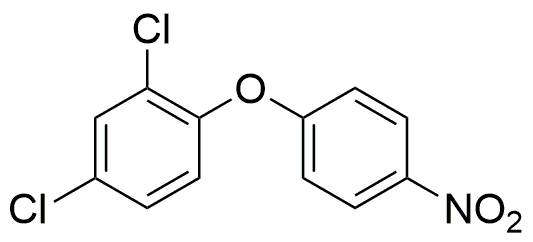2,4-Dichloro-4'-nitrobiphenyl ether is widely utilized in research focused on:
- Environmental Monitoring: This compound is used in studies to detect and analyze pollutants in soil and water, helping to assess environmental health and safety.
- Agricultural Research: It serves as a model compound in the development of herbicides, allowing researchers to understand the effects of chlorinated compounds on plant growth and pest control.
- Material Science: The chemical is incorporated into polymer formulations to enhance thermal stability and resistance to degradation, making it valuable in the production of durable materials.
- Pharmaceutical Development: It is explored for its potential in synthesizing new drugs, particularly in the design of compounds that target specific biological pathways.
- Toxicology Studies: Researchers utilize this compound to evaluate the toxic effects of chlorinated biphenyls, contributing to safety assessments for industrial chemicals.
General Information
Properties
Safety and Regulations
Applications
2,4-Dichloro-4'-nitrobiphenyl ether is widely utilized in research focused on:
- Environmental Monitoring: This compound is used in studies to detect and analyze pollutants in soil and water, helping to assess environmental health and safety.
- Agricultural Research: It serves as a model compound in the development of herbicides, allowing researchers to understand the effects of chlorinated compounds on plant growth and pest control.
- Material Science: The chemical is incorporated into polymer formulations to enhance thermal stability and resistance to degradation, making it valuable in the production of durable materials.
- Pharmaceutical Development: It is explored for its potential in synthesizing new drugs, particularly in the design of compounds that target specific biological pathways.
- Toxicology Studies: Researchers utilize this compound to evaluate the toxic effects of chlorinated biphenyls, contributing to safety assessments for industrial chemicals.
Documents
Safety Data Sheets (SDS)
The SDS provides comprehensive safety information on handling, storage, and disposal of the product.
Product Specification (PS)
The PS provides a comprehensive breakdown of the product’s properties, including chemical composition, physical state, purity, and storage requirements. It also details acceptable quality ranges and the product's intended applications.
Certificates of Analysis (COA)
Search for Certificates of Analysis (COA) by entering the products Lot Number. Lot and Batch Numbers can be found on a product’s label following the words ‘Lot’ or ‘Batch’.
*Catalog Number
*Lot Number
Certificates Of Origin (COO)
This COO confirms the country where the product was manufactured, and also details the materials and components used in it and whether it is derived from natural, synthetic, or other specific sources. This certificate may be required for customs, trade, and regulatory compliance.
*Catalog Number
*Lot Number
Safety Data Sheets (SDS)
The SDS provides comprehensive safety information on handling, storage, and disposal of the product.
DownloadProduct Specification (PS)
The PS provides a comprehensive breakdown of the product’s properties, including chemical composition, physical state, purity, and storage requirements. It also details acceptable quality ranges and the product's intended applications.
DownloadCertificates of Analysis (COA)
Search for Certificates of Analysis (COA) by entering the products Lot Number. Lot and Batch Numbers can be found on a product’s label following the words ‘Lot’ or ‘Batch’.
*Catalog Number
*Lot Number
Certificates Of Origin (COO)
This COO confirms the country where the product was manufactured, and also details the materials and components used in it and whether it is derived from natural, synthetic, or other specific sources. This certificate may be required for customs, trade, and regulatory compliance.


